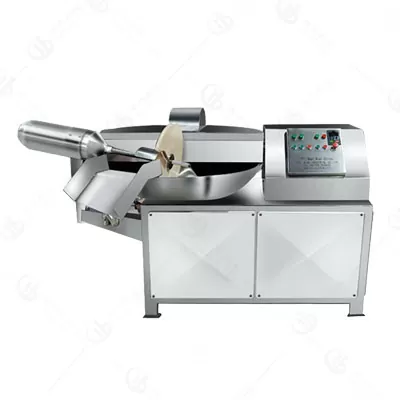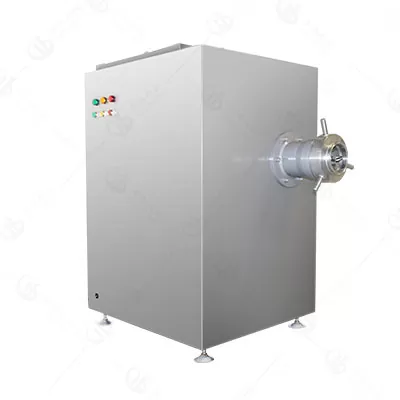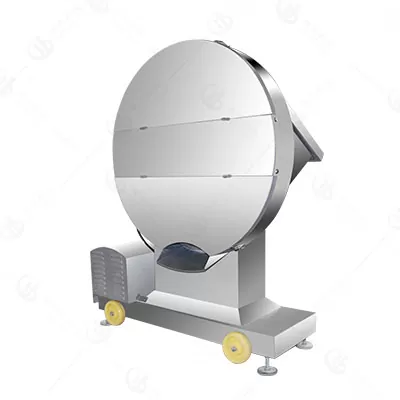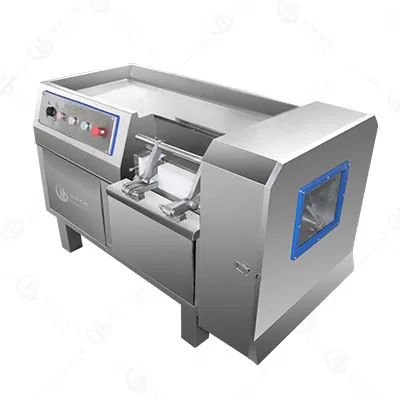Introduction
In the dynamic landscape of the food industry, the role of frozen meat processing equipment cannot be overstated. From maintaining freshness to ensuring safety and maximizing efficiency, investing in the right equipment is paramount for businesses involved in meat processing. In this comprehensive guide, we’ll delve into the world of frozen meat processing equipment, exploring its types, benefits, maintenance tips, and more.
Types of Frozen Meat Processing Equipment
Meat Bowl Chopper
The meat bowl chopper is an essential piece of equipment in the meat food processing industry, particularly for the production of finely chopped or emulsified meat products such as sausages, meatballs and meat patties. It operates with a set of sharp, rotating knives housed within a bowl, which allows it to chop and process meat efficiently, even when the meat is frozen. This machine is not only efficient but also versatile, catering to various product textures and consistencies like vegetables, fruits, dates and candied jujubes.

Key Features: High-speed rotating knives, variable speed settings, sandblasted machine surfaces, made of SUS304 stainless steel.
Benefits: Produces a fine and consistent emulsification of meat, essential for sausage, meatball and meat fillings making. It reduces labor by automating the chopping process and ensures uniformity in product texture.
Meat Grinder
The meat grinder is a staple in meat processing for its ability to grind meat into a range of textures, from coarse grinds suitable for burgers to finer grinds for sausages and other processed meats. Industrial meat grinders come in various sizes and capacities to suit different production needs. They are designed to handle large quantities of meat quickly and are an indispensable tool for any meat processing operation.

Key Features: Different grinding plate sizes, powerful motors, reverse function to clear jams, suitable for both fresh and frozen meat.
Benefits: Versatility in producing various textures of ground meat, which is crucial for different recipes. It also enhances the food safety by minimizing the time needed for handling frozen meat.
Frozen Meat Block Flaker
The frozen meat block flaker is designed to cut frozen meat blocks into thin flakes or chips, facilitating the subsequent processing steps such as grinding or mixing. This machine is particularly valuable for its ability to process meat without the need for defrosting, thereby saving time and preserving the quality of the meat. Its operation enhances the efficiency of the meat processing workflow, making it a key asset for operations looking to optimize their production line.

Key Features: Heavy-duty construction, capable of slicing through frozen meat blocks, adjustable flake thickness.
Benefits: Saves time by eliminating the need to thaw meat blocks, which also helps to maintain the meat’s quality and nutritional value. It streamlines the workflow in meat processing facilities.
Frozen Meat Dicer Machine
The frozen meat dicer machine stands out for its precision in cutting frozen meat into uniform cubes. It can handle meat that is frozen to -4℃. This machine is crucial for producing consistently sized meat pieces, which is important for both culinary applications and ensuring even cooking.

Key Features: Precision cutting blades, quick-change cutting grids, hygienic design for easy cleaning, safety design.
Benefits: Produces uniform dices for consistent cooking and presentation. It’s also efficient, reducing the time needed for manual cutting, and can handle large volumes of meat, which is ideal for commercial and industrial operations.
Each of these machines plays a vital role in the industrial meat manufacturing process, ensuring that the final products are of high quality and safe for consumption. They are designed to meet the rigorous demands of the food industry, providing reliable performance and enhancing production efficiency.
Tips for Choosing the Right Frozen Meat Processing Equipment
Choosing the right frozen meat processing equipment is crucial for ensuring efficiency, safety, and quality in your operations.
1. Assess Your Needs
Consider the types of meat you’ll be processing (e.g., beef, poultry, fish) and their forms (e.g., whole cuts, ground) and the volume of meat to be processed.
2. Quality and Durability
Look for equipment made from high-quality materials like SUS304 stainless steel that can withstand the rigors of heavy use.
3. Ease of Cleaning
Hygiene is paramount in meat processing. Choose equipment that is easy to clean and maintain to comply with food safety standards.
4. Flexibility and Versatility
Equipment that can handle various meat types and cuts offers more flexibility for different recipes and products.
5. Safety Features
Ensure the equipment has safety guards and emergency stops to protect operators.
6. After-Sales Support
Reliable customer service and the availability of spare parts from the meat processing equipment manufacturers are important for minimizing downtime.
7. Cost-Effectiveness
Consider the total cost of ownership, including initial purchase, shipping fee, maintenance, and operational costs.
8. Product Demos and Trials
If possible, test the equipment with your own product to ensure it meets your expectations. By the way, it’s a pleasure to welcome you to our factory to test the machines.
By carefully considering these factors, you can make an informed decision that will benefit your business in the long term.
Maintenance and Care Guidelines
Maintaining and caring for industrial frozen meat processing equipment is essential to ensure their longevity and optimal performance.
Regular Cleaning
Daily: Remove any meat residue and debris after each use.
Preventative Maintenance
Lubrication: Regularly lubricate moving parts to reduce friction and prevent wear.
Inspection: Regularly inspect equipment for any potential issues such as loose fittings, worn belts, or dull blades.
Calibration: Ensure that temperature controls and timers are calibrated correctly to maintain the quality of the meat.
Safety Checks
Ensure that all safety guards are in place and functioning properly. Train staff on the proper operation of equipment to prevent accidents.
By adhering to these guidelines, you can help extend the life of your equipment, maintain food safety standards, and ensure that your meat processing line runs smoothly. Always refer to the specific maintenance manual provided by the equipment manufacturer for detailed instructions.
FAQs
Q: How can I optimize efficiency in my meat processing operations?
A: Investing in high-quality equipment, implementing streamlined processes, and prioritizing staff training are key to optimizing efficiency.
Q: What types of frozen meat can be processed using industrial machines?
A: Industrial frozen meat processing machines are designed to handle a variety of frozen meat types, including beef, pork, poultry, chicken, mutton, and fish. They can process meat in different forms, such as whole cuts, blocks, or ground meat.
Q: How does a meat bowl chopper work, and what is it used for?
A: A meat bowl chopper uses high-speed rotating knives within a bowl to finely chop and emulsify meat. It’s commonly used for making sausages, pâtés, meatball, meat fillings and other products where a fine, consistent texture is desired.
Q: Can a meat grinder handle both fresh and frozen meat?
A: Yes, a meat grinder can handle both fresh and frozen meat.
Q: What is the advantage of using a frozen meat block flaker slicer?
A: The main advantage of using a frozen meat slicer is its ability to slice frozen meat blocks into flakes without the need for defrosting, saving time and preserving the meat’s quality and nutritional value.
Q: Is it necessary to defrost meat before using a frozen meat cubes cutting machine?
A: No, it’s not necessary to defrost meat. These machines are capable of dicing frozen meat directly, which helps maintain the meat’s integrity and reduces preparation time.
Q: How do I choose the right size and capacity for my meat processing equipment?
A: The size and capacity of your meat processing equipment should be based on the volume of meat you plan to process, the variety of products you intend to make, and the available space in your facility. It’s important to balance efficiency with practicality.
Q: What safety features should I look for in meat processing equipment?
A: Look for equipment with safety guards, emergency stop buttons, and lockout/tagout capabilities. Ensure that the equipment complies with local safety regulations and that your staff is trained on proper operation procedures.
Q: How often should industrial meat processing machines be serviced?
A: The frequency of servicing depends on the usage and manufacturer’s recommendations. Generally, a regular schedule of preventative maintenance and daily cleaning is advised to keep the machines in optimal condition.
Q: Can industrial meat processing equipment be customized to specific requirements?
A: Taibo, as a professional manufacturer, offers customization options for machines to meet specific processing needs, such as different cutting sizes, shapes, and additional features like temperature control or automation.
Q: What should I do if my meat processing machine breaks down?
A: If your machine breaks down, refer to the troubleshooting section of the user manual. If the issue persists, contact the manufacturer or a professional technician for assistance. Keep spare parts on hand for quick repairs to minimize downtime.
Conclusion
In the competitive landscape of the food industry, investing in high-quality frozen meat processing equipment is essential for businesses seeking to maintain a competitive edge. At Taibo Machine, we are committed to providing innovative solutions that enhance efficiency, quality, and safety in meat processing operations.
Contact us today to learn more about our comprehensive range of food processing equipment and how we can help you unlock new levels of success in your business.
More to Read
●Unlocking Efficiency in the Factory: A Guide to Carrot Processing Equipment
●A Sneak Peek into Global Food Processing Trades Shows in 2024
●Top 5 Industrial Vacuum Meat Tumbler Manufacturers in Europe

2 回复